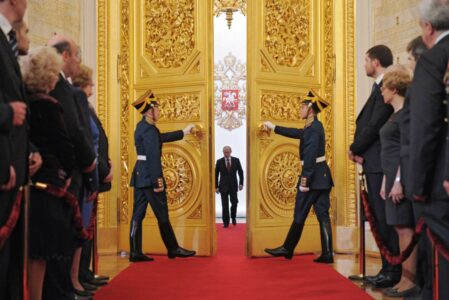
Click to see full-size image
DEAR FRIENDS. IF YOU LIKE THIS TYPE OF CONTENT, SUPPORT SOUTHFRONT WORK :
BITCOIN (BTC): bc1qv7k70u2zynvem59u88ctdlaw7hc735d8xep9rq
BITCOIN CASH (BCH): qzjv8hrdvz6edu4gkzpnd4w6jc7zf296g5e9kkq4lx
MONERO (XMR): 49HqitRzdnhYjgTEAhgGpCfsjdTeMbUTU6cyR4JV1R7k2Eej9rGT8JpFiYDa4tZM6RZiFrHmMzgSrhHEqpDYKBe5B2ufNsL
PAYPAL, WESTERN UNION etc: write to info@southfront.org , southfront@list.ru
“There is something stronger than all the troops in the world – this is an idea whose time has come”
Victor Hugo
This doctrinal article was written by Andrei Ilnitsky, Advisor to the Minister of Defense of the Russian Federation, Full State Councillor of the 3rd Class. Originally published in Parlamentskaya Gazeta in Russian. Translated by AlexD exclusively for SouthFront.
Russia has exhausted the time and social resources of inertial development. It’s time for Big Decisions and Big Projects.
What are they? This article is about them.
Big Changes
We are, after all, living in a time of change.
After decades of relative stability, humanity is entering a systemic crisis that will cause social and political upheaval in most countries.
The expert consensus on this is clear, the only dispute is over when the world will go into a “crisis peak” – 2022/2-23 or 2024/25, which on a historical scale is not the point.
The existing world order is already (!) changing radically, threatening to plunge the entire so-called “civilized world” into chaos.
Countries that will be able to withstand this period (and according to expert estimates, the “period of turbulence” will last until 2030) will create new rules and a new world order. The losers will be left behind forever, and some will only remain in history, as happened with the great empires of antiquity or some European states in the twentieth century.
The coming tide of global chaos could overtake Russia’s borders as well.
At the same time, as has happened more than once in history, the global crisis is a chance for Russia’s resurgence as one of the world leaders of the twenty-first century.
We are used to talking about our problems – supposedly, “before, the future was better…” but the bottom line is that the rest of the potential world players it – the future – is worse. The state of our army and military-industrial complex, the sharply increased level of food security, millennial historical experience, and most importantly – education, wisdom, passion and mobilization skills inherent in the Russian people, give Russia a historic chance.
Bid Ideas
The experience of human civilisation shows that the economy and the natural needs of the people are not always primary for nations. In the beginning there was the word – or rather, the big idea, the meaning of being!
What is the meaning of Russia?
First a look at the historical perspective.
Russian army’s Field Marshal General Christopher Minich, a German by birth, wrote back in 1765: “The Russian state has that advantage over all others, that it is governed directly by the Lord God Himself. Otherwise it is impossible to explain how it is governed at all…”.
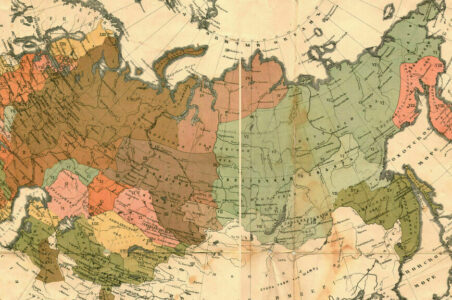
Map of the Russian Empire, 1914
And the contemporary European politician Manuel Barroso, a Portuguese politician who reflected on the same thing, once said: “Russia is a civilisation pretending to be a country”. And it is so! Russia is a historically and culturally sovereign civilisation.
The French guru of political technology, Jacques Segela, who has “elected” many presidents, has repeatedly stressed that people vote for an idea, not for a right-wing, left-wing or centrist programme! Remember Général de Gaulle saying: “I have a clear idea for France”.
Russia as an idea – what is it? Allow me to explain my vision.
It is in our vast expanses, allowing us to live without elbowing.
It is in our civilizational Orthodox mission, in a just sobornost (conciliarity) that accommodates all peoples and religions. We are all different here on the inside, and we are all Russian there on the outside, especially when trouble comes.
It is in our peacefulness. Russia is a country of peace. A country that has survived dozens of wars, lost millions, but has risen from the ashes and won, values peace like no one else.
It is in our army. A Russian soldier loves life and does not seek death, but is ready to give his life for our land – it is a military duty, and has always been so. We do not need anyone else’s, but what is ours is ours.
It is in our family life, in the beauty of our women and children, in the beautiful nature that has everything for the soul.
It is in our millennial history, where there have been revolutions, revolts, betrayal of elites, heroism of the people, great achievements, tragic defeats and resounding victories.
It is in our culture and science, of which all mankind is proud.
It is in our sovereignty. The essence of the idea of Russia is in its millennial existence itself!
Big Bifurcations
Today, Russia is at a crossroads, trying to decide on a model for the future.
Moreover, for us it can only be about our own – inherent and sovereign – decision.
In the meantime – all post-Soviet years – Russia has been moving in a catch-up development paradigm, trying to try on Western democracy. Today this model is “bursting at the seams” – it is all the more important for Russia to find its own way.
Se va el tiempo de las muñecas de carton – “The time for cardboard dolls is over” (Spanish proverb). In order to overcome the targeting and lack of will, Russia needs to decide on a strategic direction for the country that is acceptable to the majority of the population not just for the next few years, but for generations to come.
This overdue self-determination is all the more important because the West, backed by a fifth column here, has unleashed a mental war against Russia, the aim of which is to deprive us of a sovereign future by “resetting” the worldview and substituting the goals of Russians, and the youth in particular.
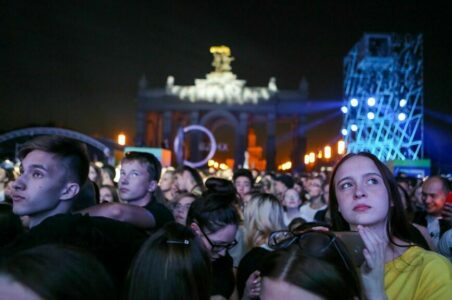
AGN Moscow/Sophia Sandurskaya
In the worst-case, “inertial catch-up” scenario, the country would lose integrity and Russia’s population could shrink by tens of millions, leaving only the “working for food” “servants” needed to keep the “pipe” running, through which natural resources are pumped to the West and China.
There is no doubt that the comprador financial-economic “elite” will give up the country and go live off their “hard-earned wealth” on their Mediterranean Riviera.
This will be the price of “no will and no action”.
Big Projects
Any complex system in its development alternates stages of accumulation with stages of change. In physics, this corresponds to an accumulation of potential energy, which at a certain point transition to a discharge and surge stage to kinetic energy.
Social systems, such as society and the state, also accumulate the potential of social energy over time – a demand for renewal, change and development. Today in Russia, the stage of accumulation is coming to an end, the stage of accumulation of the potential energy that is ready to flow out into the active, constructive creativity of society.
As attractive as stability is, it is very important not to go past the fork, not to miss the moment when it is time to translate the request for change into action – into the energy of creation. This is the wisdom of political leadership: its ability to capture that very moment. If that moment is missed, the accumulated energy can be transformed into energy of destruction rather than energy of creation. In order not to miss this fork, it is necessary to understand the situation, the underlying meanings of the processes in the system and the control mechanisms of the system.
Big Decisions – is the ability not only to capture, predict the moment of transition, but above all to lead/seat this surging wave of social energy, channeling it into creation, into what is commonly referred to in politics as “big projects that change the world”.
Big Threats and Possibilities
Geography as destiny is about Russia.
Russia needs to focus on itself.
The model of Russia of the future is a people’s empire, based on the principle of “autocracy” – not in the sense of restoring a monarchy, but in the sense of genuine people’s power, where we Russians, led by a strong state leader (the sovereign), hold our own through strong local self-government, such as the zemstvo in the late 19th century.
The implementation of this “framework model” requires political will, a new strategy for the geo-social and geo-economic organisation of the country, based on the three pillars of security, people preservation and territorial-economic cohesion.
The current strategy of resource concentration in megacities, imposed on Russia from outside, contradicts its civilizational code and lays an infrastructural and geopolitical bomb under our future.
It is necessary to form an anti-crisis socio-economic model of mobilisation type built into the public administration system, not only to duplicate/insure against various kinds of hybrid crises such as coronavirus or technogenic failures in the future, but – and this is most important – to form a platform for stable development throughout the entire space of our vast country for decades to come.
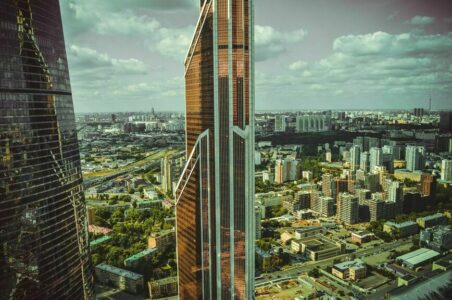
© Pixabay
Nassim Taleb, a famous American analyst, the world’s leading expert on forecasting the future of the global economy, the author of the “black swan” concept, who predicted the crisis of 2008, predicted a crisis of megacities catalysed by a covidal epidemic. He wrote: “There is a growing trend that will “kill the cities” – people will start migrating en masse from megacities to small towns and the countryside”.
Here I will briefly list only some of the vulnerabilities and threats of the megacity concept of territorialisation:
- megacities are extremely vulnerable to epidemics and all kinds of man-made disasters;
- sociologists attest: a megacity is comfortable to live in only if there is social harmony, otherwise it turns into a “stone jungle”;
- all the mass protests of recent decades – colour revolutions, national liberation movements, bloodless and bloody coups – have all had capital cities and megalopolises as their central stage;
- megacities “produce loneliness”, alienate people from each other. This reduces trust and solidarity in society, which is critical for Russia;
- Moscow and St-Petersburg now account for a third of Russia’s GDP. More people live in these two megaregions than on the other side of the Urals;
- The Moscow region alone, which occupies no more than one per cent of the territory of the Russian Federation, absorbs almost one fifth of the total Russian population;
- Forced to congregate in narrow, limited point zones, the inhabitants of our megacities are losing creative energy, existing in superdensity: today, with 1/7th of the world’s land mass, we live 7-10 times more crowded, cramped and stacked than the English and Germans.
“Crowding” and concentration of population in megacities is a trend that is multidirectional with the Russian civilisation code.
In this concept imposed on us by the West, Russia loses its main geopolitical and geostrategic advantage – the colossal spaces collected and bloodily preserved by our ancestors over hundreds of years.
The conclusion is that the main lesson of the corona crisis and the “resource curse” of the economy should be the spatial and territorial redevelopment of the country, because a balanced distribution of economic and population growth points is a key element of Russia’s national security.
Addressing these issues is urgent, as the lack of a socio-spatial strategy in Russian politics has already led to the depopulation of territories, the formation of social wastelands and the creation of “belts of alienation” – satellite towns and suburbs populated by paupers, often ethnically coloured.
It is necessary to move from enlargement and concentration to reasonable dispersal, to the formation of a single standard of governance and quality of life throughout Russia.
Russia’s Big Project
Russia has always “pulled itself out of the swamp by its hair” with Big Projects – from the Yermak campaign and the conquest of Siberia to the Trans-Siberian Railway, space, the nuclear project, the Russian Artic and reunification with Crimea.
The cities and development territories of Siberia and the Far East, which already have many types of resources, industrial and scientific potential, but lack human resources and managerial competencies, as well as the main problem and threat – depopulation – could become such a Big project for Russia.
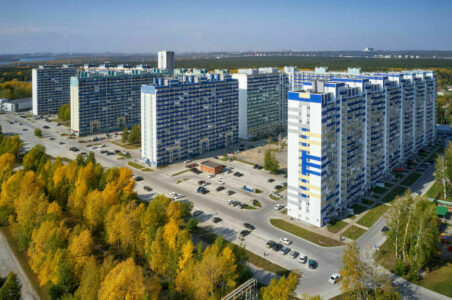
Bird’s eye view of new buildings in the Berezovoe district in Novosibirsk © Lori.ru
Let me remind you of the classic definition of Siberia: it is the entire eastern part of Russia – from the Ural Mountains to the Pacific Ocean.
It was with the development of Siberia that Muscovy Rus became Russia, the great Euro-Asian power.
Siberia is a key linking regions between the Arctic, the Far East, Central Asia and the European part of Russia.
There, in Siberia, the existing cities can be modernised, but first of all, new cities must be built in comfortable natural-climatic zones, cities of the modern type, whose location and development logic will be tied to natural resources.
These will be cities of the most advanced architecture with developed infrastructure and science, education and healthcare, cities that are comfortable, attractive and interesting to live in – young people above all.
These cities of the people’s empire will become the “assembly points of the Russian world”!
Speaking to the scientific community in Novosibirsk, Russian Defence Minister Army General Sergey Shoigu spoke of the urgent need to build three to five research and industrial centres in Siberia with a population of between 300,000 and 1 million people.
It is the scientific, industrial and economic centres that will become new poles of attraction for the population from all over Russia, as well as for our compatriots from near and far abroad.
Such centres will give a powerful impetus to the development of the Siberian region and ultimately to the sustainable development of the entire (!) Russian economy.
It is not just a question of building new settlements, but of developing the Siberian macro-region and the country as a whole.
Let us recall Mikhail Lomonosov’s prophetic thought: “Russia’s power will grow by Siberia and the Northern Ocean. And it will reach the main European settlements in Asia and America”. It is no coincidence that Lomonosov wrote Siberia and the Arctic Ocean with an “and”. They should be developed together, not separately. That is why focusing on the development of the Siberian region along with the Arctic is timely and justified today.
As Sergei Shoigu stressed: “We need to build a modern ‘Cedar Route’ – a safe and efficient route between Europe and China…”. The need for such a transport corridor, and above all a secure one, is already very clear, if one only recalls the recent events with the blockage of the Suez Canal, the pirate attacks and the current situation in Afghanistan. It is also important for international transport flows. And for Russia, the Cedar Route is also of great importance as an opportunity to integrate into global production chains between Europe and the Asia-Pacific region.
Big History – the Trans-Siberian
The great sage Goethe wrote roughly as follows: “Courageous thoughts play the role of the leading checkers in the game; they often perish from misunderstanding, but ensure the final victory…”.
Russia has successful experience of big projects. Let us recall here, perhaps, the main one – the Trans-Siberian Railway: how and why it was born, how the Big Decision about it was made.
On March 17, 1891, Emperor Alexander III signed a rescript. “I order to start building a continuous railway across Siberia to connect the abundant natural gifts of the Siberian regions with the network of internal communications,” the tsar ordered. A month earlier, the Committee of Ministers of the Russian Empire had also ruled that work could begin on the Great Siberian Road simultaneously on both sides. It was decided that “the Siberia railway, a great national undertaking, should be carried out by Russian people and from Russian materials”.
The Russian Army was then at the forefront of the Big Project: the Trans-Siberian as a project was created by military engineers, cartographers, railwaymen, topographers and other specialists.
What was the main strategic goal of this Big Project?
In preparation for the Imperial Decision, the General Staff submitted a report on 5 December 1890, which was read by Colonel N.A. Voloshinov at a meeting of the Imperial Russian Geographical Society (now the Russian Geographical Society). It noted: “…When considering the issue of a continuous, uninterrupted road across the whole of Siberia, one must first of all give an answer as to what it is needed for. It is necessary to distinguish the main, guiding purpose of the construction, and depending on it all the rest will be determined… The purpose of the great uninterrupted road across the whole of Siberia is not to develop arable farming in the South or raise the gold industry in the North, but to destroy the unfavourable effect of the enormous distances, to compress this entire long and narrow strip, to bring the Pacific Ocean closer to European Russia and to connect the rivers cutting through the fertile areas of Siberia.”
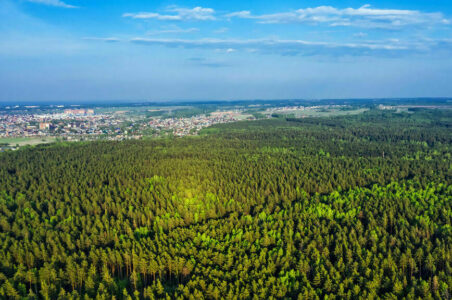
Bird’s eye view of the pine forest surrounding the city Berdsk, Novosibirsk region, Western Siberia © Lori.ru
In other words, the Trans-Siberian’s highest priority was not to exploit Siberia’s wealth, but rather to ensure the coherence of a gigantic empire.
Life has fully confirmed the correctness of this strategy!
It is crucial to understand this today, when part of the elite perceive Siberia only as a resource centre for extracting and transferring wealth.
Any change or adjustment of course is a breach of the elite’s status quo, it is a tension and a need for action. Now, alas, much of our economy is the economy of raw material exports and financial and currency transfers. The “Siberian Turnaround” is changing everything dramatically. There is a political will to switch to a mobilisation format of development.
Just as the Great Project “Siberian Turn” is now, so then the Trans-Sib caused “brainstorming and confusion” among the liberal intelligentsia and resistance among some elites – local and central – who fidgeted in their entrenched places of comfort.
There were many opponents to the construction of the great highway: fears of swamps, dense taiga with beasts, merciless frost, bogs, impassable rivers, wild aborigines and much more. Supporters of the path linking Russia were declared to be dreamy swindlers and mentally ill people.
There was also resistance among the elite.
The Minister of Internal Affairs, Ivan Durnovo, argued two years before construction began that the creation of the Trans-Siberian railway would lead to a massive uncontrolled resettlement of peasants to Siberia, which would empty the villages in the interior provinces and drive up the price of labour in the cities.
The local “czars” were not silent either. “The first thing to expect from the road is an influx of all sorts of swindlers, artisans and traders, then buyers will turn up, prices will go up, the province will flood with foreigners and it will become impossible to keep order”, the Tobolsk governor worried.
But the most persistent and fierce critic was Ivan Vyshnegradsky, the then Minister of Finance, who, “horrified by the unprecedented price of the road”, suggested (sic!!!) a way out – foreign investment from the (!) Rothschild bankers themselves, whose preliminary consent he had already obtained by that time. But Tsar Alexander III, fastidious in connections, did not approve this decision.
More than a hundred years have passed, but how similar it all is to the present day, how it almost verbatim resembles the criticism of the new Big Project – it is only worth changing some names and outdated definitions.
Sergey Kuzhugetovich reminded these “critics” in his interview: “At a meeting with the president, where important macroeconomic projects were discussed, I do not remember exactly who said: “There is no money”. To which Vladimir Vladimirovich replied: “There will never be any, unless you start doing something”.
It is appropriate to conclude this section with the parable of the disciple who asked the sage teacher, “How long to wait for change?” – “If you wait, it will be a long time”.
Big Ideology
Ideology is needed when it becomes a motive for real action; ideology is not needed for inaction. The ideology of active offensive movement is needed today.
What is the ideology of the Big Project?
Here are just the main paradigm:
-
the transition to a mobilisation economy and partial closure from a disintegrating global world;
-
the decisive importance of the leadership, organising role of the state;
-
the state takes control of the economic, information and geographical space of the country;
-
the idea of a single economic plan for the country as the key organising document for the revival and restructuring of the domestic economy based on a synthesis of the best aspects of state planning and market self-organisation;
-
subordinating the financial system to the goals of economic growth, providing the economy with cheap and long money;
-
the new territorial policy is a priority for the state. Abandoning the strategy of megapolitan urbanisation. From a territory of sixteen megacities and depopulated vast areas, Russia should transform into a uniformly populated and developed low-rise country;
-
the formation of a single standard of governance and quality of life throughout the Russian Federation. Workplace, schools, clinics, FASs (first aid stations), pharmacies, shops, cultural centres, outdoor sports, leisure activities and more should all be preserved and provided everywhere and, where necessary, recreated locally;
-
the nationalisation of the elites according to the principle of “whoever is not with us is against us”. Those “who are not with us” should realise that they risk losing everything. The meritocratic principle of forming a new managerial cadre. The goal is to reset the elites under the Big Project by transferring some of the capital’s functions to Siberia;
-
ensuring that socio-economic development priorities are maintained at all times;
-
education is the most important and key link in the new strategy. It is the social core of the entire Big Project implementation mechanism. The implication is a dramatic increase in teacher welfare. By status: all teachers are civil servants;
-
increase in the level of people’s satisfaction and happiness (happiness index). The citizen satisfaction index should be mandatory and cross-cutting for all national projects, state programmes and other strategic planning documents of socio-economic orientation;
-
the growth of real income of the population. This indicator should be of primary importance and GDP growth of subordinate importance;
-
reliance on the traditional values, history and culture of Russia;
-
assembling the “Russian World” — the return to the country of compatriots living abroad;
-
the key indicator is population growth, including an increase in the birth rate to at least the natural reproduction rate;
-
security issues are key! This is the basic platform for the implementation of the Big Project and the development of Russia as a whole;
-
Russia’s army and the military-industrial complex – the centre of mobilisation, economic revival, including the principles of control and planning based on the State Defence Order (SDO);
-
Russia’s army is the main source of the ideology of serving the Fatherland, the centre of formation and education of new nationally-oriented managers for the state (education, medicine, science, etc.) and, among other things, for the revival of Russia through Big Projects;
-
Geo-social policy is strictly linked to the military-territorial order and security issues of the country.
Conclusion
State power is the centre of Russia’s crystallisation. It has no right to be weak, disconnected from the people and unsure of the country’s prospects for decades to come; it must be capable of making big decisions!
The great Russian philosopher Vasily Rozanov wrote: “The only vice of the Russian state is its weakness. A weak state is not already a state, it simply does not exist”.
The essence of the proposed Big Project is the preservation and multiplication of the land and people of Russia. This strategy has been put forward by President V.V. Putin in his Addresses and enshrined in amendments to the Constitution.
Yes, it is difficult and even risky business. But this is the historical mission of the Russian authorities in the third decade of the 21st century. This mission is a duty to the succeeding generations.
The time for Big Decisions has come!








